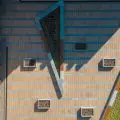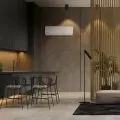A team of architects from Jan Strumillo's studio has designed the interior of the oldest bookstore in Poland, located in a tenement in the heart of Krakow. What is the effect? See for yourself!
The Kromerowska Tenement House is one of the historic buildings of Krakow's Market Square. At 23 Market Square, a bookstore has been operating since 1610 and remains so to this day. Today, three rooms on the first floor house the Empik chain store, which was redesigned by a team of architects from the Warsaw-based Jan Strumillo studio.
Ola Kloc: Designing in such a prestigious location and historic interiors is quite a challenge. What was the most difficult part of this project for you?
Jan Strumillo: The rooms subjected to our changes are located in the depths of a very long store, also we had to reckon with the fact that not everyone can get there. This creates a temptation to reach for strong effects, but we had to be very careful with this. Especially since we wanted to refer to the front part of the premises, located outside our study, filled with beautiful antique alder wood furniture. Other historic elements, such as the stone portals, beamed ceiling and old brick walls, also had to fit into our proposal. We also had to find ways to abstractly reflect the characters of two well-known public figures.
The use of natural materials of good quality is not at all easy - natural wood has to be treated with special solutions in order to obtain the required non-flammability certificates. Unfortunately, in the current environment the easiest way to build with laminates and other artificial materials, regulations make it difficult to use wood. This can make one nervous, especially since half of the store is antique wooden furniture. Well, dura lex, sed lex. The fact that we are operating next to an antique also has the effect of making the paperwork sprawl beyond the average.
Ola: What kind of interior atmosphere did you want to achieve with your choice of colors, materials and fabrics?
Jan: We wanted to build a cozy, homey atmosphere, similar to the one in which the most important works of Nobel Prize winners were created. We generally aimed for the 1960s, so we used stylized furniture, and gave the built-ins the character of "wall units," similar to those that filled cramped apartments in the years of the key works. Wislawa Szymborska patronizes the first, brighter of the rooms. The patron's crotchety disposition inspired the colorful mustachioed upholstery. Czeslaw Milosz gave his name to the deeper room, and we made it darker, furnishing it with fabrics and colors reflecting the poet's dark and often uneasy side. In concept, there was still a metal ceiling meant to reflect the menacing, cloudy Central European sky, but it was unfortunately lost somewhere in the battle. The corridor was to remain fairly neutral, providing a transitional element. The mural gives it new value.
Left: Wislawa Szymborska hall, right: Czeslaw Milosz hall
© Empik
Ola: How did you come up with the idea to invite Tymek Jezierski to work with you and put the vaulting of the bookstore corridor in his hands?
Jan: As an architect, I provide a rational component, with only a slight touch of artistic frenzy, but for such a serious thing as painting the ceiling of a long corridor, my modest artistic component is simply not enough and I have to resort to professionals. We have been working with Tymek for a long time, including for this unique client, and have had some very successful joint ventures. I know his experience with murals and know that I can fully trust him with creative issues. Especially since, working in the same space, we can always discuss the progress of projects and any concerns on an ongoing basis. In this case, the agreement of the three parties - the client, the architect and the artist - worked particularly well. Tymek managed to work out such a concept of graphics that matched well with the shape I proposed and the concept of a "narrative bookstore" that Empik had developed. As a result, the "pantheon of Krakow artists" emphasizes the architecture, fits in with the unique history of the place and creates value in itself, because the characters are so aptly and attractively rendered that they have already begun to live their own lives, for example, Szymborska's cat painted near the entrance has already found its way onto souvenir mugs.
Ola: Thank you for the interview!

























































